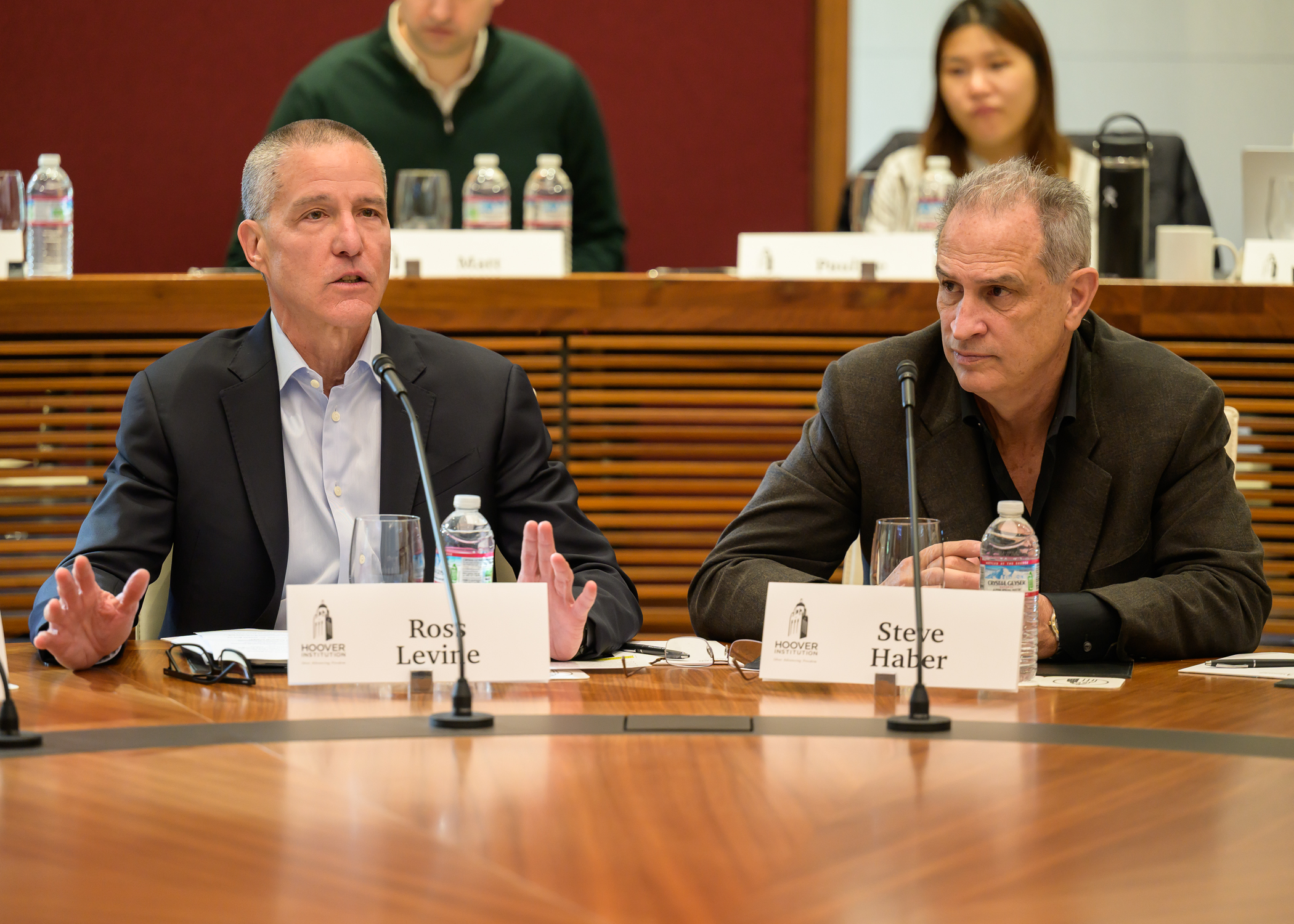The Hoover Institution’s Banks and Beyond conference brought together scholars, industry leaders, and regulators to grapple with the question: What happens when lending, payments, and risk taking migrate from tightly supervised banks to lightly regulated non-bank financial intermediaries (NBFIs)? Over the course of two days, the program featured two keynote addresses, a high-level panel discussion, and five research papers that painted a vivid picture of the coevolution of the industry and regulation, as well as the opportunities and challenges arising from these dynamics.
The conference was organized by Hoover Senior Fellows Stephen Haber, Ross Levine, and Amit Seru, who lead the Hoover Program on the Foundations of Economic Prosperity and codirect the Financial Regulation Working Group.
“The efficiency and stability of the financial system are essential for fostering economic growth, expanding opportunities, and enhancing the human condition,” noted Levine in introductory remarks. “Bringing together policymakers, industry leaders, and researchers to examine the evolving financial landscape is crucial for expanding opportunities, boosting innovation and growth, and enhancing overall prosperity.”
The Evolution and Regulation of Non-Bank Lending
Isil Erel of the Ohio State University delivered the first of two keynote speeches, emphasizing the threefold increase in private-debt fund assets over the past decade and the challenges this poses for regulators. She argues that this surge reflects insufficient access to bank credit, particularly for middle-market firms; stricter bank regulations that have driven such financing outside of banks; and the flexibility and innovation provided by these non-bank financial intermediaries (NBFIs).
In a second keynote, Nicola Cetorelli of the Federal Reserve Bank of New York first reminded the audience that the movement of financial activities from heavily regulated banks to other financial intermediaries is not a new phenomenon. He then demonstrated that while many activities have moved beyond the regulatory boundary, significant connections remain between the growth of NBFIs and banks, raising concerns about how the evolving structure of financial intermediation impacts systemic risk.
Private Debt Versus Bank Debt in Corporate Borrowing
How does the extraordinary growth of private debt—the money that businesses borrow through NBFIs rather than by issuing publicly traded bonds or obtaining traditional bank loans—interact with bank lending? Do private-debt lenders compete with banks for the same borrowers, or do they cater to a different segment of borrowers?
Irina Stefanescu of the Federal Reserve Board and coauthors investigate these questions. By combining administrative bank loan-level data with information from non-bank private-debt deals, they find that many US firms borrow from banks and private-debt lenders simultaneously (link research brief). These “dual borrowers” tend to be larger, riskier companies with fewer collateralizable assets and higher leverage than firms that borrow only from banks. Moreover, the authors find that banks and private lenders provide complementary services. Banks supply revolving credit lines—effectively, liquidity insurance—while private-debt funds offer larger, longer-maturity term loans that absorb more risk.
Interest Rate Risk in Banking
Were Silicon Valley Bank’s failure and the systemwide stresses of 2023 triggered by temporary liquidity pressures or solvency concerns? More broadly, how should policymakers assess whether banks are fundamentally solvent, even when market shocks temporarily reduce the value of their assets?
To address these questions, Peter DeMarzo of the Stanford Graduate School of Business and his coauthors focus on franchise value—the present value of the expected profits banks will earn from their core business of lending and deposit taking. The authors’ key finding is that franchise value falls when interest rates rise (link research brief) for a large majority of US banks, which conflicts with the prevailing view of bank regulators. However, DeMarzo and his coauthors find that banks’ median franchise value declined by about 2.2% of assets during the 2023 interest rate hikes, yet it remained positive for most banks.
Beyond Banks: The New Era of Financial Intermediation?
Senior leaders from private credit firms, renowned scholars, and former policymakers engaged in a candid and extensive panel discussion. Moderated by Amit Seru, the panel examined the recent shift of lending from traditional banks to private credit providers.
The panelists returned repeatedly to three themes:
- Speed and Customization. Private credit funds can price and close deals in weeks, tailoring covenants and amortization schedules for each borrower. Banks cannot.
- Bank–NBFI Symbiosis. Far from engaging in a zero-sum competition, banks often provide credit lines or securitization warehousing to NBFIs. It would be a mistake to view NBFIs merely as substitutes for banks, as they provide complementary services to firms and rely on banks for their operations.
- Regulatory Lag. Regulatory agencies struggle to keep pace with rapidly evolving financial systems. Frequent communication among industry leaders, policymakers, and researchers is essential for maintaining a resilient, innovative, and efficient financial system that fosters economic growth and expands opportunities.
Bank Capital and the Growth of Private Credit
A standard critique of private credit firms is that they thrive because of regulatory arbitrage: They exploit regulatory loopholes and beat out banks by operating with less capital. Is this true?
David Scharfstein of Harvard Business School and his coauthors reject this view. In their paper, they demonstrate that business development companies (such as KKR, Blue Owl, and Oaktree), which represent a significant portion of the private credit landscape, maintain remarkably high capital ratios—a median of 36%, which is 26 percentage points above what would be required under the Federal Reserve’s bank stress-testing framework. Scharfstein and his coauthors propose that the true driver behind the private credit boom is that banks find it more profitable to lend to private credit funds (link research brief) than to originate and monitor middle-market loans themselves.
Failing Banks
Why do banks fail? Are failures due to liquidity crises, such as deposit runs, that cause the fundamentals of banks to deteriorate? Or do failures indicate insolvency that sometimes triggers deposit runs? The implications for supervisory and regulatory policies are critically important.
Using a remarkable dataset of US bank failures from 1865 to 2023, Stephen Luck and his paper’s coauthors point to insolvency. They find that simple balance-sheet indicators—such as asset losses, falling equity, and an increasing reliance on expensive non-core funding—reliably predict collapse (link research brief). Runs typically follow deteriorating fundamentals rather than preceding them. The policy punch line is that tougher capital and asset-quality standards may deliver more stability than back-stop liquidity facilities alone.
Noisy Experts: Discretion in Regulation
Much of the edifice of bank supervision and regulation is built on bank examiners evaluating banks’ capital, assets, management, earnings, liquidity, and sensitivity to market risk, i.e., CAMELS ratings. How noisy are these evaluations? To what extent does a bank’s CAMELS ratings depend on who examines them in any given year?
In their paper, Amit Seru and his coauthors present a striking finding: The highly trained examiners conducting these high-stakes assessments exercise significant discretion when assigning CAMELS ratings, and the bank’s ratings can vary considerably based on which inspector they randomly receive. These discretionary judgments trigger substantial behavioral responses from banks, including a reduction in loan growth and an increase in capitalization, as banks adopt conservative strategies to navigate the uncertainty introduced by examiner variability. Zeroing out discretion would eliminate valuable information that examiners gather on site, but limiting discretion and offering clearer guidelines could enhance consistency and accuracy.
Seru noted at the conclusion of the conference, “As finance moves beyond traditional banks, the need to rethink regulation, and sometimes deregulation, has never been more urgent. At Hoover, we’re building the evidence base and convening the right people to ask hard questions: What should be regulated? What shouldn’t? And how do we foster prosperity without courting instability? This conference showed how rigorous research and cross-sector dialogue can drive smarter financial policy for the future.”
About the Hoover Program on the Foundations of Economic Prosperity
The Hoover Program on the Foundations of Economic Prosperity conducts evidence-based research on the institutions and policies that foster economic prosperity amid today’s public policy challenges. The program is dedicated to producing research that empowers citizens and policymakers to make informed decisions around a core question: What combination of policies, institutions, and regulations is most likely to foster long-term economic prosperity?
About the Financial Regulation Working Group
Which financial regulatory reforms promote economic prosperity? And why do societies find it so difficult to create financial systems that are both efficient and stable? The Financial Regulation Working Group convenes an interdisciplinary network of scholars from economics, finance, law, political science, and history. Our goal is to spur research addressing these pivotal questions and disseminate the findings to the research community, policymakers, and the wider public. The Financial Regulation Working Group is an initiative of the Hoover Program on the Foundations of Economic Prosperity.






























